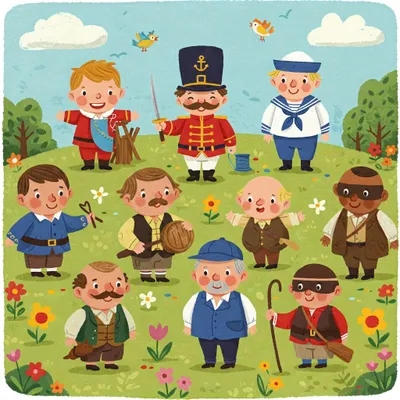Tinker, Tailor

Lyrics
Tailor,
Soldier,
Sailor,
Rich Man,
Poor Man,
Beggar Man,
Thief.
History and Meaning
"Tinker, Tailor" is a traditional English nursery rhyme that functions primarily as a counting game and fortune-telling method. While the familiar rhyme structure likely solidified over time, earlier precedents involving lists of common professions or social roles exist from centuries past. A similar categorization of societal roles appears in William Caxton's "The Game and Playe of the Chesse," printed around 1475, which names the pawns as "Labourer, Smith, Clerk, Merchant, Physician, Taverner, Guard and Ribald." The first documented instance of the specific opening sequence—Tinker, Tailor, Soldier, Sailor—being grouped together occurs in William Congreve's play "Love for Love" from 1695, suggesting these core professions had entered common language by the late 17th century.
The rhyme serves a distinct dual function in traditional children's culture. Firstly, it works as a "counting-out" rhyme, a simple method for randomly selecting someone from a group, often to determine who will be "It" in games like tag. The process involves pointing sequentially at each participant while reciting the stressed syllables of the rhyme; the person indicated on the final syllable is chosen. This practice connects to a long history of using rhymes for selection, potentially stemming from older methods of divination by lots. Secondly, and perhaps more famously, "Tinker, Tailor" serves as a fortune-telling game, particularly for young girls seeking to divine aspects of their future. The most common purpose was to predict a future husband's profession, though it could also foretell one's own destiny.
The divination involves counting a series of items—cherry stones after eating, buttons on clothing, daisy petals, ball bounces, or rope skips—while reciting the list of professions. The profession named on the count corresponding to the final item becomes the prediction. Longer versions extend beyond occupations to include marriage timing ("This year, next year, sometime, never"), future attire ("Silk, satin, cotton, rags"), mode of transport to church, and other life details. This dual use—as both a game randomizer and fate determiner—highlights the fluid boundary between play and belief in folk practices, where simple counting formulas take on different significance depending on context and intent.
The list of professions has evolved over time with notable regional variations. The most common modern version in the UK runs: "Tinker, Tailor, Soldier, Sailor, Rich Man, Poor Man, Beggar Man, Thief." In the United States, a frequently encountered version goes: "Rich Man, Poor Man, Beggar Man, Thief, Doctor, Lawyer, Indian Chief." Earlier collected versions show further variation; James Orchard Halliwell in the 1840s recorded a button-counting rhyme starting "My belief – a captain, a colonel, a cow-boy, a thief." A.A. Milne's 1927 collection included an expanded version for counting cherry stones, adding roles like cowboy, policeman, jailer, engine driver, and rocket man. This evolution reflects changing social structures and prominent cultural archetypes across centuries, from medieval roles to maritime and military figures, stark wealth disparities, professional classes, and distinctly American characters.
Beyond its practical uses, "Tinker, Tailor" offers a window into historical perceptions of social roles and hierarchies. The listed professions span society's spectrum, from itinerant craftsmen (Tinker) and essential tradesmen (Tailor) to figures of authority (Soldier, Sailor) and the extremes of economic status (Rich Man, Poor Man, Beggar Man) and criminality (Thief). The fortune-telling focus on determining a future husband's profession underscores the historical emphasis on marriage as a primary determinant of a woman's social standing and economic security. The rhyme's cultural resonance extends into modern times, most famously in John le Carré's espionage novel "Tinker Tailor Soldier Spy," but also in works by Ellery Queen and Tom Clancy, and even as a Marvel Comics title, demonstrating how these simple verses continue to echo through contemporary creative expressions.